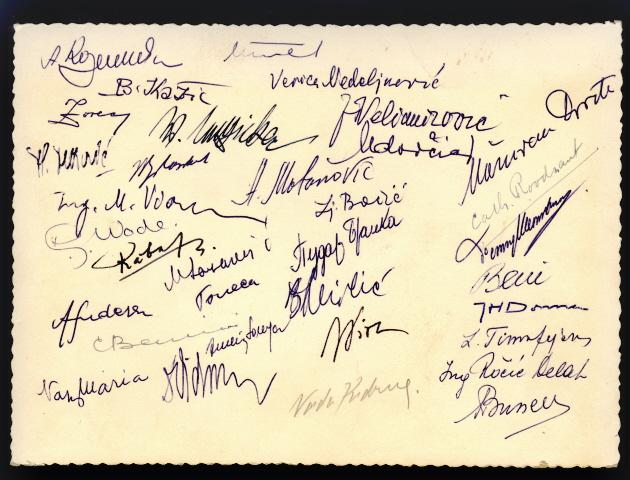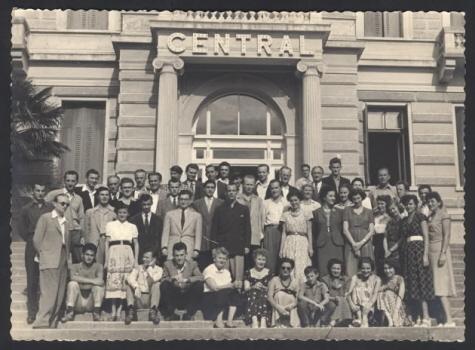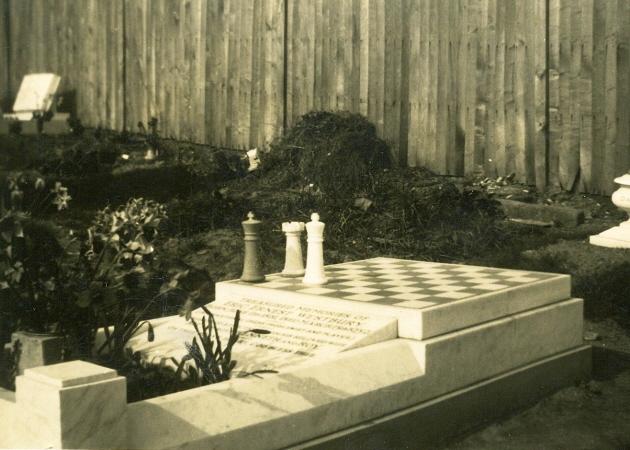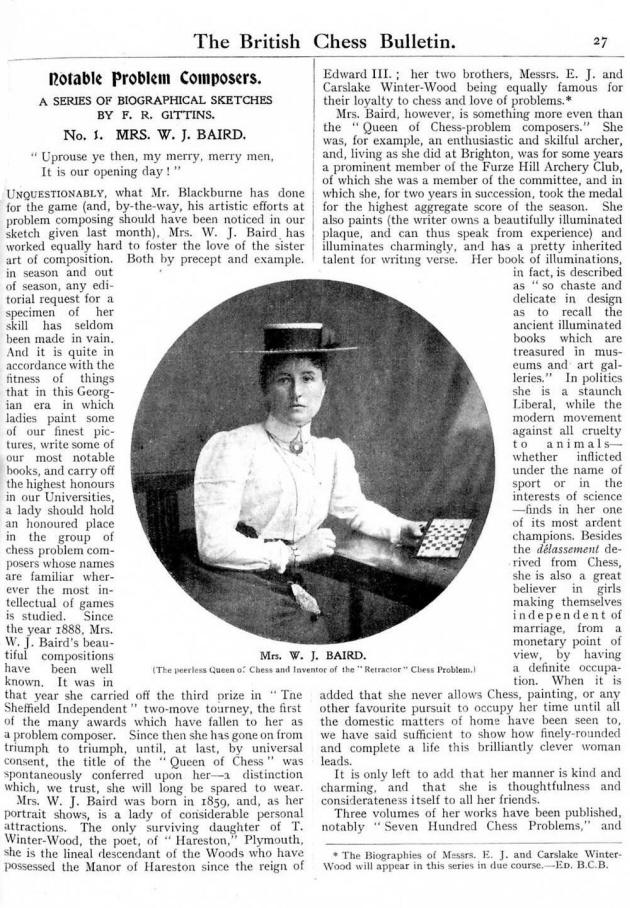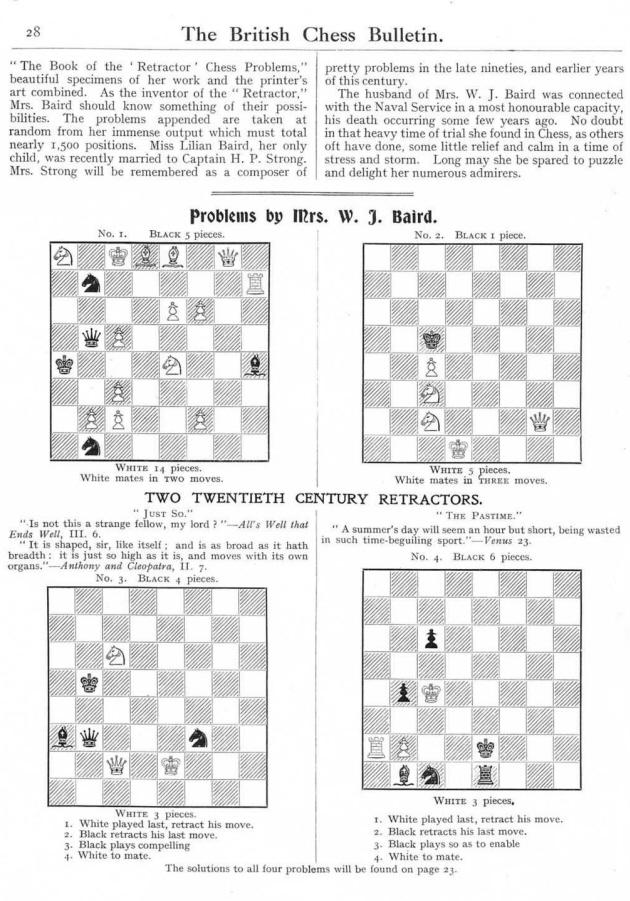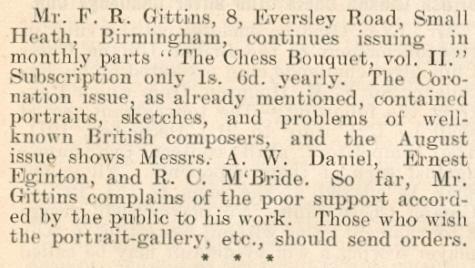Chess
Notes
|
| First column | << previous | Archives [66] | next >> | Current column |
6438. Displacement chess
Eduardo Bauzá Mercére (New York, NY, USA) sends a game from page 8 of the Brooklyn Daily Eagle, 17 January 1894:
John Duryea Elwell – Hermann Helms
Novelty Tournament, Brooklyn, January 1894
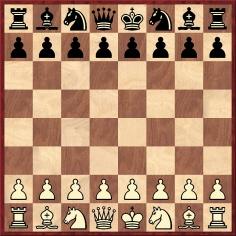
1 f3 c6 2 c3 e5 3 d4 Ne6 4 e3 d5 5 Nb3 f6 6 Bf2 Bf7 7 Bd3 Ne7 8 Ng3 O-O 9 O-O Bg6 10 Qc2 f5 11 dxe5 Bxe5 12 f4 Bc7 13 Nd4 Nxd4 14 cxd4 Qd7 15 b4 Rae8 16 Rfe1 Nc8 17 Rac1 Re6 18 Nxf5 Ref6 19 Nh4 Bxd3 20 Qxd3 Nd6 21 Nf3 Ne4 22 Ne5
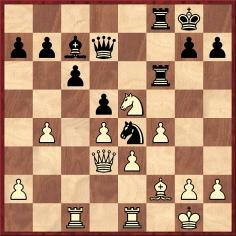
22...Qf5 23 Qe2 Nxf2 24 Qxf2 Bxe5 25 dxe5 Qxe5 26 Qd2 Qe4 27 g3 Re6 28 Qd4 Rfe8 29 Kf2 Qf5 30 Qxa7 R8e7 31 a4 g5 32 Qc5 Qh3 33 Kg1 gxf4 34 Rc2 Rxe3 35 Rf1 Re2 36 Rxe2 Rxe2 37 White resigns.
Other examples of displacement chess are on pages 88-90 of The Encyclopedia of Chess Variants by D.B. Pritchard (Godalming, 1994).
6439. Chaim Janowski
C.N.s 367 and 525 briefly discussed Chaim Janowski (the brother of Dawid), and the latter item mentioned that John Rather (Kensington, MD, USA) had sent us a portrait of him in Księga Jubileuszowa Łódzkiego Towarzystwa Zwolenników Gry Szachowej 1903-1938 (Łódź, 1938):
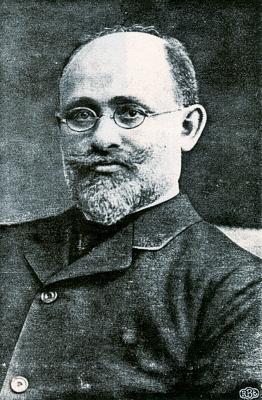
Chaim Janowski
Below are two games published on pages 42-43 of volume two of Arcymistrzowie, mistrzowie, amatorzy ... by Tadeusz Wolsza (Warsaw, 1996):
Chaim Janowski – S. RosenblatŁódź, 1898
Queen’s Gambit Accepted
1 d4 d5 2 c4 dxc4 3 e3 e5 4 Bxc4 exd4 5 exd4 Nf6 6 Qb3 Qxd4 7 Bxf7+ Kd8 8 Be3 Qb4+ 9 Nc3 Qxb3 10 Bxb3 Bd6 11 O-O-O Ke7 12 Bg5 c6 13 Nf3 Rd8 14 Ne4 h6 15 Rhe1 Kf8 16 Nxf6 Bf4+ 17 Bxf4 Resigns.
Georg Salwe – Chaim JanowskiŁódź, 1905
King’s Gambit Declined
1 e4 e5 2 f4 Nc6 3 Nf3 d6 4 Bc4 Be6 5 Bxe6 fxe6 6 fxe5 dxe5 7 d3 Nf6 8 O-O Bc5+ 9 Kh1 O-O 10 Nc3 Ng4 11 Qe2 Nd4 12 Nxd4 Rxf1+ 13 Qxf1 Bxd4 14 g3 Qe8 15 Nd1 Qh5 16 h4 Rf8 17 Qe1 Nf2+ 18 Nxf2 Qf3+ 19 Kh2 Bxf2 20 White resigns.
Wolsza’s book records that Chaim Janowski died in 1935, his year of birth being unknown. On page 16 of the January 1956 Chess Review Ossip Bernstein described him as ‘a wealthy merchant in Łódź’.
6440. Blackburne (C.N. 6437)
Olimpiu G. Urcan (Singapore) points out a report on page 5 of the Melbourne newspaper The Argus of 22 January 1885 which is favourable to Blackburne’s side of the fisticuff affair:
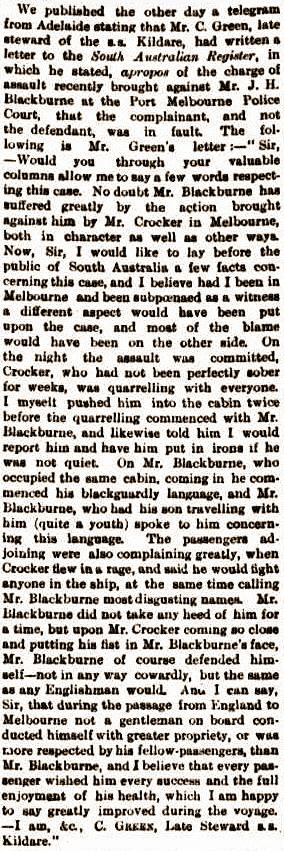
6441. Consulting books
C.N. 1979 (see page 214 of Kings, Commoners and Knaves) mentioned a report on page 65 of La Stratégie, March 1904 that in a Rice Gambit tournament at Monte Carlo that year the competitors received The Rice Gambit by H. Helms and H. Cassel (New York, 1904) and were allowed, during play, to consult it, as well as any other documentation.
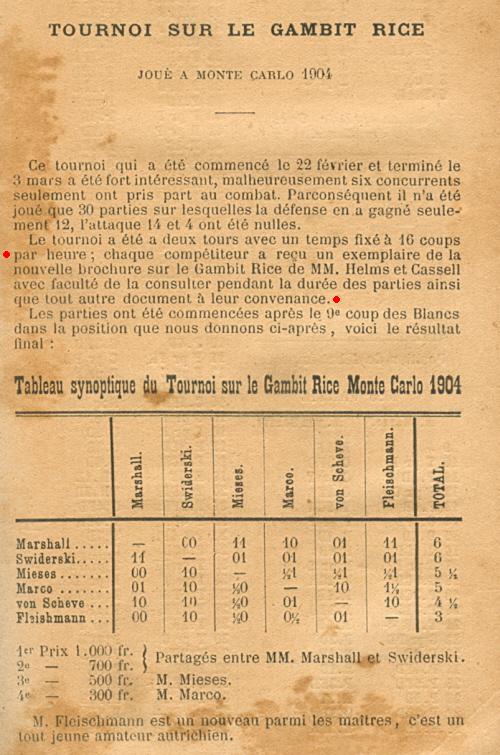
Now, Henk Smout (Leiden, the Netherlands) notes that Georg Marco gave a rather different account of the playing terms on page 168 of the June 1904 Wiener Schachzeitung. The opening moves were 1 e4 e5 2 f4 exf4 3 Nf3 g5 4 h4 g4 5 Ne5 Nf6 6 Bc4 d5 7 exd5 Bd6 8 O-O Bxe5 9 Re1:
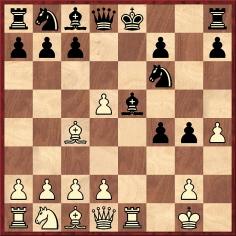

In short, Marshall protested that Swiderski had gone beyond the rules, which merely allowed the booklet The Rice Gambit to be consulted, and not other documentation (such as rough cuts of material due to be published in the Wiener Schachzeitung).
Our correspondent comments:
‘As noted by the Wiener Schachzeitung at move 16, the pages from the magazine which Swiderski was studying and which he was forced to hand over to Marshall (who refused to look at them) included Alapin’s advice on page 90 of the February-March 1904 Wiener Schachzeitung that instead of 16...f4 Black should take the draw by perpetual check.’
Below is the relevant phase of the Swiderski v Marshall game:
9...Qe7 10 c3 g3 11 d4 Ng4 12 Bxf4
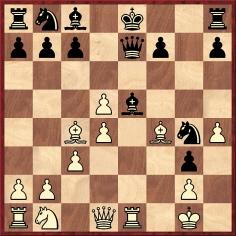
12...Bxf4 13 Rxe7+ Kxe7 14 Qf3 Be3+ 15 Kh1 f5 16 Na3
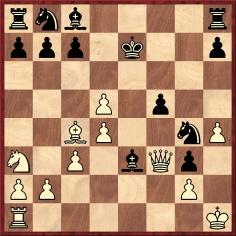
Here Marshall played 16...f4 and eventually lost.
6442. Capablanca photographs
Pages 304-305 of our book on Capablanca gave the six games of an odds match which he won in Havana in March 1941 against three leading Cuban players. The scores were published in Ajedrez Cubano by Mario Figueredo (Havana, 1941), and from that scarce book we now reproduce nine photographs featuring Capablanca:

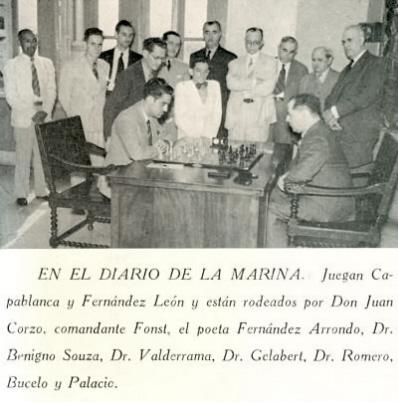
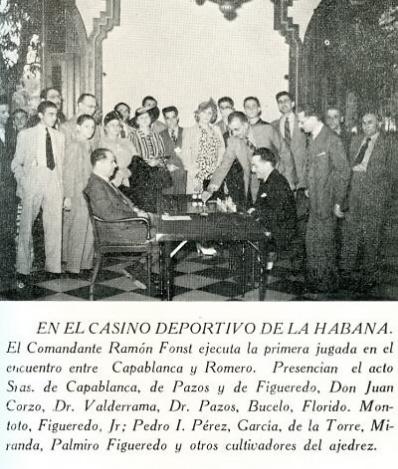
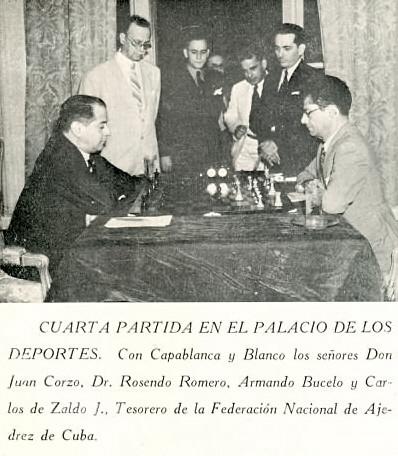
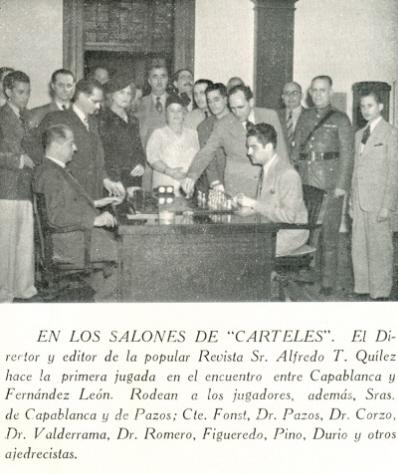
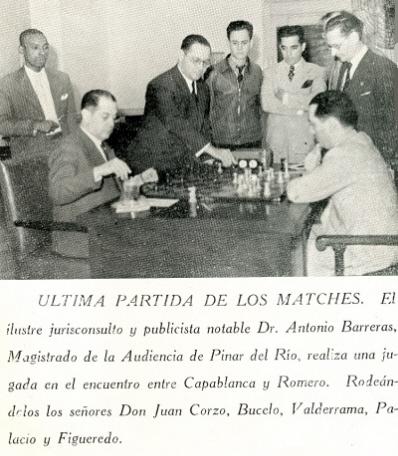
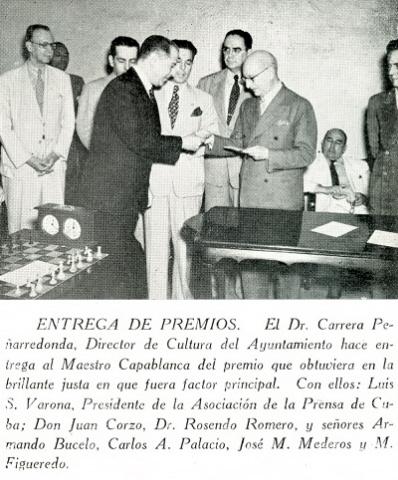
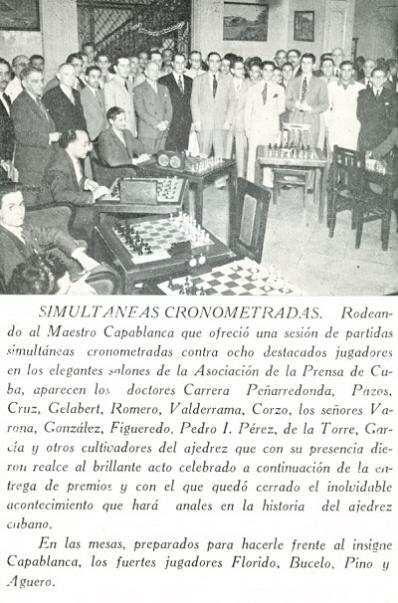
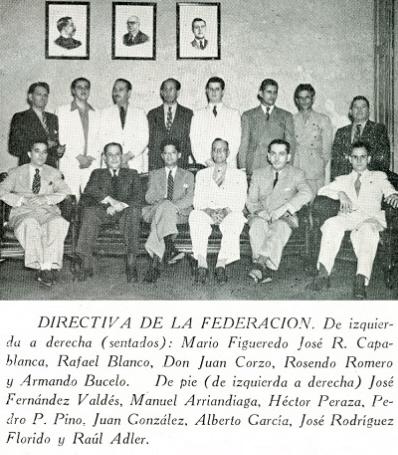
6443. Olympiad performance
It is common knowledge that Capablanca participated in only one Olympiad (Buenos Aires, 1939), though not common enough. From page 35 of The Big Book of Chess by Eric Schiller (New York, 2006):
‘The reigning champion, Jose Capablanca, had played in the initial 1927 Olympiad event.’
6444. F.K. Young and B.F. Winkelman
Henrique Marinho (Curitiba, Brazil) notes that Chapter X of Modern Chess by Barnie F. Winkelman (Philadelphia, 1931) has a discussion of Franklin K. Young and that in Chapter XX (page 180) the following paragraph appears:
‘In the work of Mr F.K. Young mentioned in a previous chapter, certain recognized formations were advocated by him, but the principles underlying the proper co-ordination of the pieces were never touched on. Mr Harold Perrin, a strong amateur of Boston, sensed the real situation when he stated that chess is not a status, but a flux, and this emphasis upon the ever-changing relations of the forces rightly describes the real situation.’
Information about the relevant writings of Perrin would be welcomed.
6445. P-Q4
From page 106 of Winkelman’s above-mentioned book:
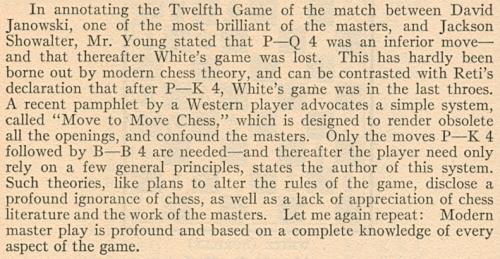
As regards the reference to Réti, see Breyer and the Last Throes.
The following notes by Young to the Janowsky v Showalter match-game (concerning, respectively, 1 d4, 1...d5 and 2 c4) appeared on page 362 of the February 1899 American Chess Magazine:
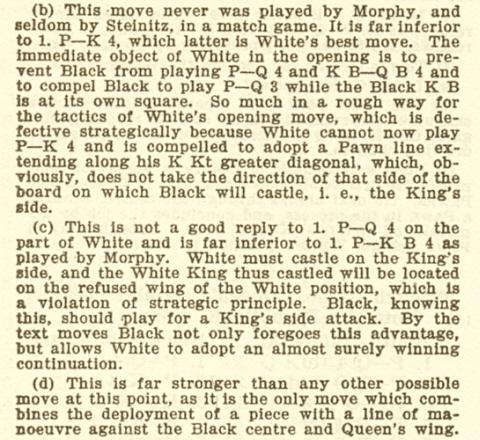
6446. Non-chess book
As mentioned in C.N. 2601 (see page 192 of A Chess Omnibus) Barnie F. Winkelman wrote a non-chess biography, John G. Johnson (Philadelphia, 1942). Below is an inscription from our collection:
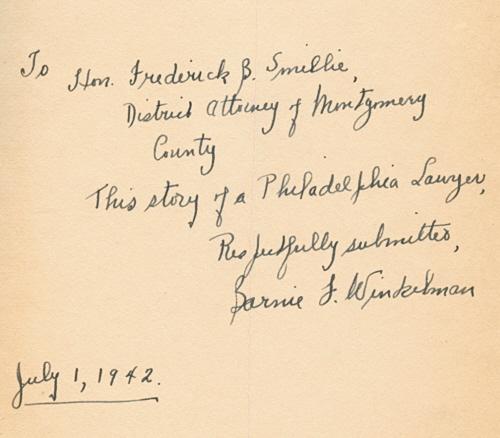
6447. For and against
A staunch defender of Franklin K. Young was Charles W. Warburton, in his book My Chess Adventures (Chicago, 1980). See, in particular, pages 2, 13-14, 42 and 94-96. Below is a sample passage from page 95:

Warburton did not name the Englishwoman, but she was Eileen Tranmer, on page 187 of Chess Treasury of the Air by Terence Tiller (Harmondsworth, 1966):
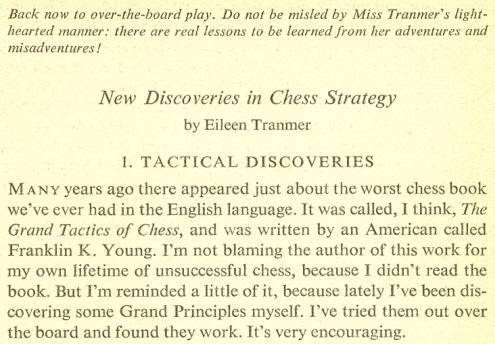
This photograph of F.K. Young comes from page 71 of The Rice Gambit (souvenir supplement to the 1905 American Chess Bulletin):
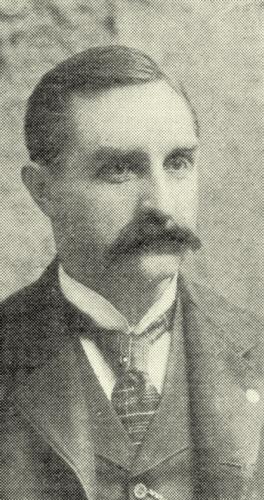
6448. Postcard (C.N. 6406)
This difficult exercise will need to be taken gradually. In the photograph Leonard Barden (London) identifies: B. Rabar (standing in the front on the left, with dark glasses); A. Matanović (seated on Rabar’s left); A. Fuderer (seated two places to Matanović’s left); B. Milić (second man from the right standing at the back); V. Pirc (seventh man from the right standing at the back).
What correlation is there between the photograph and the signatures? The latter include B. Kažić, W. Unzicker, H. Golombek, M. Vidmar Jr., R. Wade, A. Fuderer, M. Vidmar, A. Matanović, C. Roodzant, A. Beni and J.H. Donner.
6449. Who? (C.N. 6435)
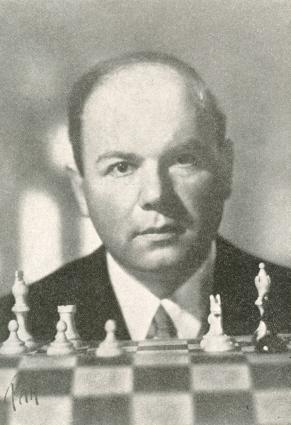
This photograph is of Harald Malmgren and was the frontispiece of his book Mina Bästa Partier (Örebro, 1953).
Pages 30-31 give this game:
Harald Malmgren – Ernst JohanssonCorrespondence, 1935
Caro-Kann Defence
1 e4 c6 2 d4 d5 3 exd5 cxd5 4 c4 Nf6 5 Nc3 Nc6 6 Bg5 Qb6 7 cxd5
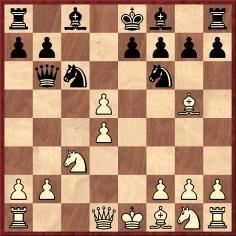
7...Nxd4 8 Nge2 Qxb2 9 Rb1 Resigns.
In a database we have seen Black’s seventh move mistranscribed as ...Nxd5.
6450. New York, 1886
From Rod Edwards (Victoria, BC, Canada):
‘On page 52 of volume one of his Chess Tournament Crosstables Jeremy Gaige gives the crosstable of a Manhattan Chess Club Tournament dated 1886. Gino Di Felice has the same table on page 103 of his Chess Results, 1747-1900. The May 1886 BCM (pages 210-211) reported the results, though without the crosstable. (Di Felice apparently misnames it the “9th Manhattan Chess Club ch.”, which was a different event played later in the year – see page 363 of the August-September 1886 BCM.)
None of these sources mentions any odds-giving, but was it a handicap tournament? Or, if they were not receiving odds, who were Hyde and Hartshorne? According to the crosstable, Hyde came equal second with G.H. Mackenzie, behind J.S. Ryan. Hartshorne was fourth, just half a point behind Mackenzie and Hyde. J.M. Hanham, E. Delmar and D.G. Baird, all well-known players, finished lower down.’
The tournament was indeed a handicap event, played from 9 November 1885 to 10 April 1886. The conditions were set out on page 17 of the Brooklyn Chess Chronicle, 15 November 1885:
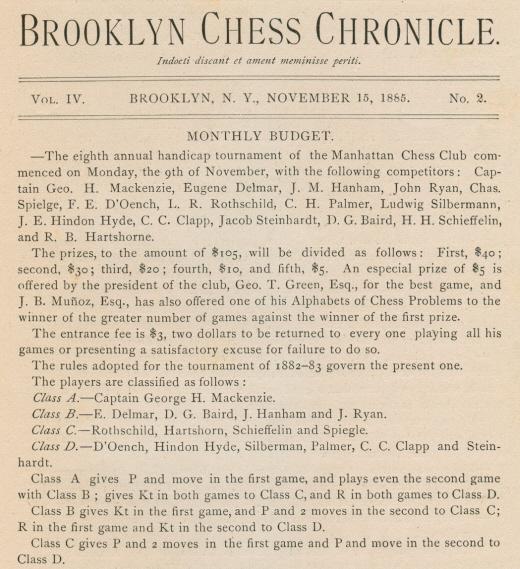
The crosstable on page 98 of the Chronicle of 15 April 1886 gave the top scores as 1 Ryan (17½) 2-3 Hyde and Mackenzie (16½) 4 Hartshorne (16) and 5 Hanham (14½), as in Gaige’s Crosstables book. However, the Chronicle preceded the table with the following note (on page 97):
‘The Manhattan Chess Club Tournament came to an end on the 10th inst. As will be seen by the following full score, Mr Ryan appears to be one game ahead of Messrs. Mackenzie and Hyde; but as he lost one game to Mr Silberman – withdrawn – that game is scored against him, thus making a tie for first prize between Messrs Mackenzie, Ryan and Hyde; Mr Hartshorne wins the fourth prize and Mr Hanham the fifth.’
The three-way tie for first place was confirmed on page
114 of the 15 May 1886 issue of the Chronicle,
as well as page 111 of the May 1886 International
Chess Magazine (and pages 210-211 of the May 1886
BCM).
The Chronicle gave a few of the games, including the following one on page 138 of the 15 June 1886 issue.
George Henry Mackenzie – F.E. D’OenchNew York, 1885 or 1886
(Remove White’s queen’s rook.)
1 c4 c5 2 e3 e6 3 a3 d5 4 Nf3 dxc4 5 Bxc4 Nc6 6 Nc3 Nf6 7 O-O Be7 8 d4 cxd4 9 exd4 h6 10 Ba2 a6 11 Re1 O-O 12 Bb1 Nh7 13 Qd3 f5 14 Ba2 Rf6 15 b4 Rg6 16 Qxf5 Rf6 17 Qe4 Kh8 18 Ne2 Bd6 19 Bb2 Ne7 20 Bb1 Nf8
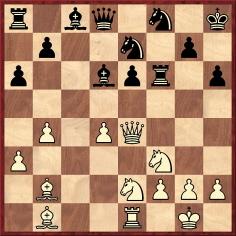
21 d5 exd5 22 Qh4 Neg6 23 Qh5 Nf4 24 Nxf4 Bxf4 25 g3 Bc7 26 Re8 Qd6 27 Ne5 Kg8 28 Ng6 Rf7 29 Qh4 Qb6 30 Ne7+ Kh8 31 Bd4 Qd6 32 Bc5 Qd7 33 Qxh6+ gxh6 34 Bd4+ Resigns.
Page 129 of the same edition of the Chronicle reported regarding this victory that ‘Captain Mackenzie received the prize of $5 for the most brilliant game’.
Four other games by Mackenzie (against Delmar and Ryan) were annotated by Steinitz in the International Chess Magazine in 1886.
6451. Simultaneous displays in Moscow
C.N. 2816 (see page 71 of Chess Facts and Fables) sought ‘lesser-known instances of masters making unfavourable scores in simultaneous displays’.
As regards a well-known case (+0 –20 =10 by R.G. Wade
in Moscow, 1951), we should like to know whether the
Soviet press of the time published any of the games.
H. Golombek referred to that display on pages 127-130 of Instructions to Young Chess-Players (London, 1958):
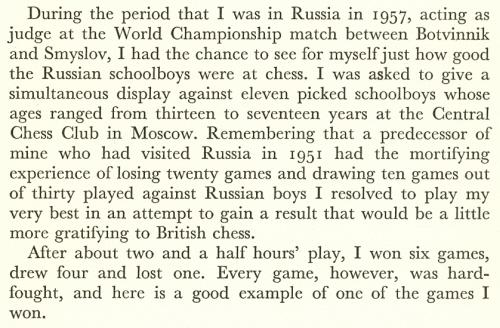
Harry Golombek – L. Barchatov
Simultaneous exhibition, Moscow, 1957
Queen’s Gambit Declined
1 c4 Nf6 2 Nc3 e6 3 Nf3 d5 4 e3 Be7 5 Be2 O-O 6 O-O Nbd7 7 b3 b6 8 Bb2 Bb7 9 d4 c5 10 cxd5 exd5 11 Rc1 Rc8 12 dxc5 bxc5 13 Na4 Nb6 14 Bxf6 gxf6 15 Nb2 d4 16 exd4 Bxf3 17 Bxf3 cxd4 18 Qd2 Rxc1 19 Rxc1 f5 20 Rd1 Bf6 21 Qf4 Qd7 22 Nd3 Rc8 23 Qh6 Qd6 24 g3 Rc2 25 Re1 Be7 26 Qh5 Rxa2 27 Qxf5 Qf6 28 Qg4+ Kh8 29 Nf4 Qg5
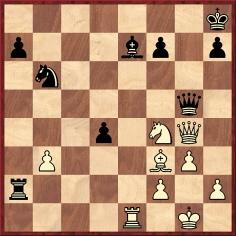
30 Qh3 Rb2 31 Be4 h6 32 Ra1 a5 33 Rxa5 Qf6 34 Rf5 Qg7 35 Nh5 Qg6 36 Re5 Qd6 37 Qf5 Resigns.
6452. Alekhine story
Daniel King (London) asks for information on the old story about Alekhine playing two games, with alternate colours, against a pair of amateurs who hatched a scheme whereby the master’s moves in the first game were repeated against him in the second one, the aim being to ensure that he could not win both games.
We recall the following feature on pages 48-50 of the February 1927 Wiener Schachzeitung (a special ‘chess humour’ issue):
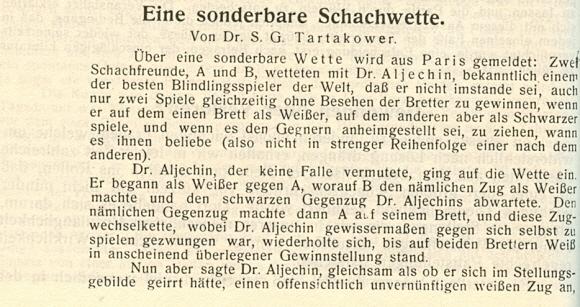
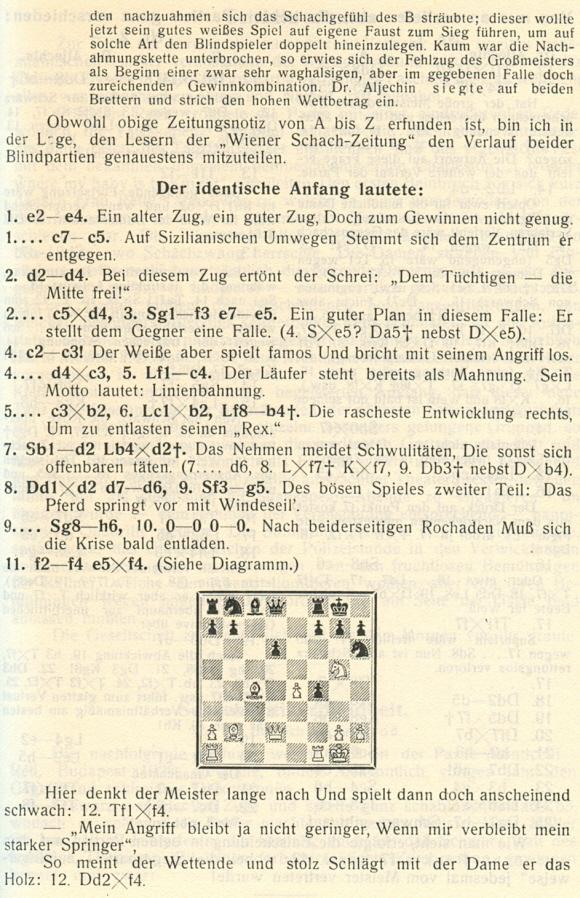

6453. The gymnasium of the mind (C.N. 3626)
For reasons unknown, the imprint page of volume one of Chess Generalship by Franklin K. Young (Boston, 1910) credited a famous observation to H.T. Buckle:
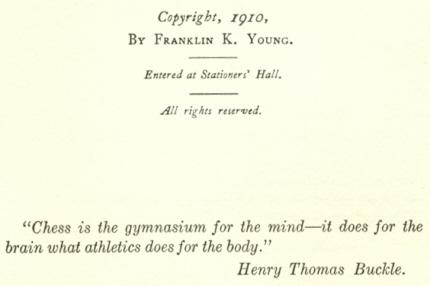
Young had written similarly on page 408 of the Pall Mall Magazine, 1897 (volume 11), in an article entitled ‘The Major Tactics of Chess’:

6454. Postcard (C.N.s 6406 & 6448)
Goran Tomić (Herceg Novi, Montenegro) informs us that the photograph was taken in Opatija in 1953 (international tournaments for men and women held concurrently):
‘Standing from left to right are: J. Nikolac, B. Rabar and B. Kažić. In front of them, seated, are M. Bertok, A. Fuderer and B. Kićović. Seated third from the right is J. Velimirović (with her young son Dragoljub), and behind her is V. Nedeljković. Standing behind her in the back row and in the dark jacket is D. Kićović. Third on Kićović’s left is B. Milić, and third on his right is Pirc. Four places to the right of Pirc is I. Buljovčić.
I received this information from Dragan Kićović. Moreover, Vojin Vujošević has informed me that the woman standing third from the right, with her hands clasped in front of her is Tilka Vuković (later Tilka Miličić).
Some of the above names were given in C.N. 6448, but I believe that the first player seated on the left is not A. Matanović but M. Bertok.’
We are also grateful to Alan McGowan (Waterloo, Canada), who identified the occasion as Opatija, 1953.
6455. Staunton consultation game
Dan Quigley (Augusta, GA, USA) asks about an encounter involving Löwenthal and Staunton (London, 1856) which may be found listed in databases as a consultation game:
1 e4 e5 2 Nc3 Nf6 3 f4 d5 4 fxe5 Nxe4 5 Nf3 Bg4 6 Be2 Nc6 7 Bb5 Bb4 8 Qe2 Ng5 9 Qf2 Bxf3 10 gxf3 O-O 11 Bxc6 bxc6 12 Ne2 f6 13 h4 Ne6 14 c3 Ba5 15 d4 fxe5 16 dxe5 d4 17 Bd2 Qd5 18 Rf1 Bb6 19 Qg3 d3 20 Nc1 Rad8 21 Nb3

21...a5 22 c4 Qxc4 23 Bc3 Bd4 24 Nxd4 Nxd4 25 Kd2 Ne6 26 f4 Nc5 27 Rae1 Ne4+ 28 Rxe4 Qxe4 29 Rf2 Rf7 30 Qe3 Qf5 0-1.
Our correspondent also mentions a database where 21...a6, and not ...a5, is given.
We note that the game was published on pages 28-29 of the 1859 Chess Player’s Chronicle:
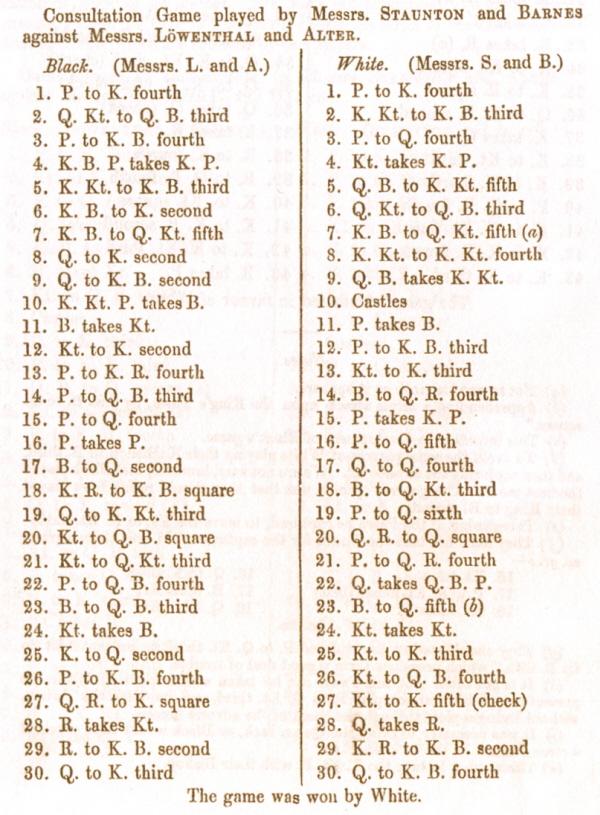

Löwenthal’s partner (‘Alter’) was John Owen.
Another consultation game (Löwenthal and Barnes v Staunton and Alter) was on pages 26-28 of the Chronicle, with this introduction on page 26:
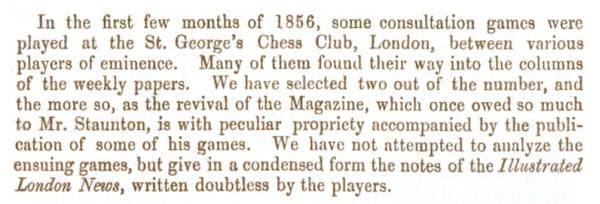
With regard to the Illustrated London News, Rod Edwards (Victoria, BC, Canada) kindly informs us that the game under discussion was in Staunton’s column on page 258 of the 8 March 1856 issue (with 21...a5). Mr Edwards adds:
‘After Staunton and Barnes’ 30...Qf5, Staunton stated in the Illustrated London News that “The remaining moves were not recorded, but the game was won by White”. It should be borne in mind that Staunton and Barnes had the white pieces.
It was one of a series of consultation games played between Staunton and Löwenthal in which each player had various allies. Sometimes the allies even switched partners. The series was announced on page 187 of the 16 February 1856 Illustrated London News, where the result of the first two games was given. Cumulative scores were provided periodically, and the last tally that I have found was in the 13 September 1856 magazine (page 281): “Staunton and Co.” had nine wins and “Löwenthal and Co.” five, with two games drawn. However, consultation games between Staunton and Löwenthal with various allies continued to be reported sporadically until the 4 July 1857 issue (page 22).’
6456. Sabadell, 1945
Further to our article Mysteries at Sabadell, 1945, Andrés Vicente Sanz (Valencia, Spain) sends us two newspaper cuttings which provide some additional information and complications.
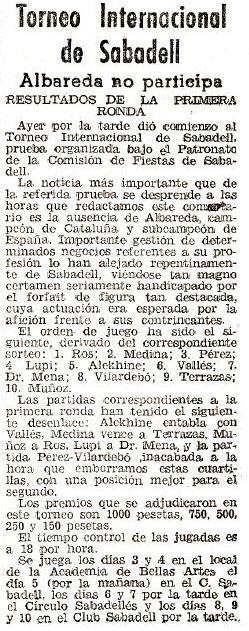
The above report on page 2 of El Mundo Deportivo, 3 August 1945 gives the results of the first round, played the previous day, and lists, in the final paragraph, the remaining tournament schedule: daily rounds at various venues in Sabadell from 3 to 10 August, with play in the morning on 5 August.
However, El Mundo Deportivo of 4 August 1945 (page 3) has the following:

This presents not only the results of round two in Sabadell but also a report on a simultaneous exhibition by Alekhine (+17 –4 =9) in Saragossa, the same day (3 August). The display took place from 18.00 to 22.30, and our correspondent wonders how Alekhine could have played a tournament game in Sabadell in the afternoon and, starting in the early evening, an exhibition about 250 kilometres away (accompanied in Saragossa by F. Lupi).
6457. E.E. Westbury
From Michael McDowell (Westcliff-on-sea, England):
‘Some years ago I gave a lecture to the British Chess Problem Society about E.E. Westbury, an excellent composer whose work deserves to be better known. The text was reproduced in The Problemist and later added to the BCPS website. [Updated link.]
Recently I was contacted by the composer’s grandson, Ian Westbury, who found the website article while researching his family history. He sent me two photographs of his grandfather and two of his grave in Erdington, taken in 1939, the year he died. The grave is adorned with a marble board and pieces (the pieces have apparently disappeared over time) and has this inscription:
“Treasured memories of Eric Ernest Westbury, born June 11th 1881, died March 15th 1939 (International chess problemist and player). A tribute of affection from his beloved wife Kit and boys Kenneth and Roy. Oh true brave heart, God bless thee.”
It must be unusual for an epitaph to refer specifically to the deceased as a chess problemist, and I wonder whether there are any others. Eric Westbury certainly had international fame as a problemist, but I doubt that the “international” was intended to accompany “player”, although he played on top board for Worcestershire.’
Mr McDowell has also forwarded to us, courtesy of Ian Westbury, a photograph dated July 1924. Can any information be traced about the occasion (e.g. based on the trophy)?
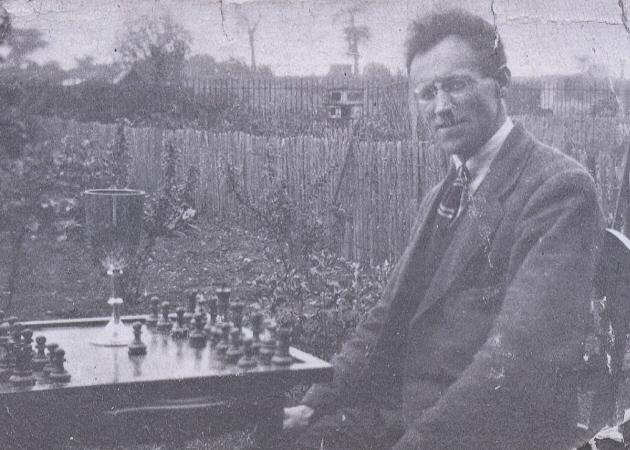
Eric Ernest Westbury
6458. Atlantic City, 1921
Potted biographies of Dawid Janowsky seldom mention his victory in the Eighth American Chess Congress at Atlantic City, NJ in 1921, ahead of Norman Whitaker and Charles Jaffe, with Frank Marshall finishing equal fifth. A photograph was published on page 214 of “Our Folder” (the publication of the Good Companion Chess Problem Club), August 1921:
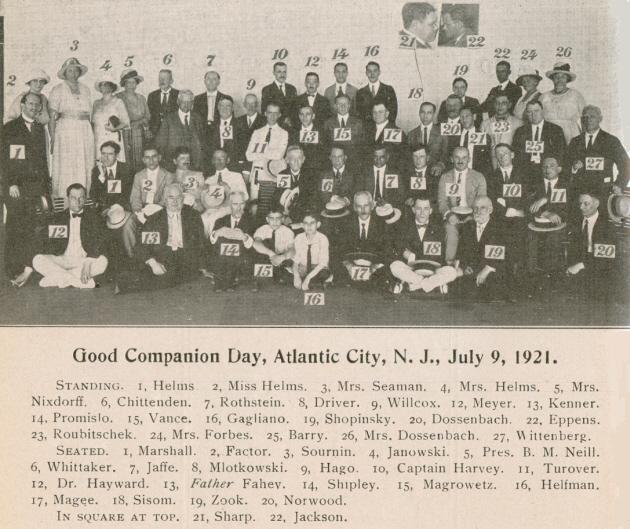
The same picture, without the numerical references, appeared on page 128 of the July-August 1921 American Chess Bulletin, with this key on the next page:
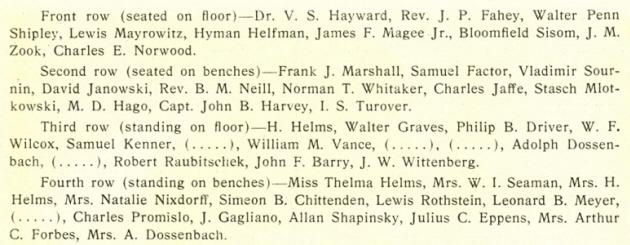
Larger version of the photograph
6459. Frederick Richard Gittins (C.N. 5391)
C.N. 5391 asked for information about F.R. Gittins, the author of The Chess Bouquet (London, 1897).
From Michael Clapham (Ipswich, England):
‘Page 36 of the Chess Amateur, November 1909 mentioned a novel in preparation by Gittins entitled Life on nothing per week:
“It consists of a striking and vivid exposition of the latter day death struggle to live, with attempted solutions of many pressing problems of today.”
The price was three shillings and the address was the one given in C.N. 5391 (8 Eversley Road, Small Heath, Birmingham).
The June 1910 issue of the Chess Amateur, page 260, included an announcement by Gittins of the preparation of two volumes:
“The Chess Bouquet, Vol. II, on the Book of the British Composers of Chess Problems and One Hundred British Chess Players.”
These two works were mentioned again in the September 1910 Chess Amateur, page 356, and the latter book was included in Frank Hollings’ advertisement opposite that page.
Page 17 of the December 1910 British Chess Bulletin (see C.N. 6307) announced the first of a series of biographical sketches entitled “Notable Problem Composers” by F.R. Gittins, and it was stated that each article would include a photograph of the composer dealt with, these being taken from Gittins’ new book One Hundred British Chess Players. This seems to indicate some confusion over the two works.
The first biographical sketch, on pages 27-28 of the December 1910 Bulletin, was of Mrs W.J. Baird, and the second, on pages 37-38 of the January 1911 issue, dealt with Carslake Winter-Wood. No further articles appeared.
Gittins also compiled an article on pages 15-16 of the November 1910 British Chess Bulletin entitled “The Jubilee of Mr J.H. Blackburne” and celebrating his 50 years of chess play.
None of this material was published in book form, although The Chess Bouquet Vol. II was issued in monthly parts. This is confirmed by reports in the Chess Amateur in 1911 and 1912. Page 355 of the September 1911 issue published the following:
Page 485 of the January 1912 Chess Amateur stated that it had received from Gittins No. 3 of his Chess Bouquet, containing “12 problems by W.J. Wood, with his biography, and an article on J.H. Blackburne”.
The van der Linde-Niemeijeriana collection in The Hague has a note to its online entry for The Chess Bouquet: “with specimen pages of The Chess Bouquet Vol. 2 (never published)”. However, this is not recorded in Betts’ Bibliography and is not in the British Library or the J.G. White Collection in Cleveland. Similarly, I can find no mention of One Hundred British Chess Players in any library catalogue or bibliography.’
Information is also sought on the above-mentioned novel Life on nothing per week.
We add that on page 55 of the November 1907 Chess Amateur Philip H. Williams launched a testimonial fund for Gittins, who ‘has been out of employment for a distressingly long time’. Many leading problemists answered the call. Williams wrote that The Chess Bouquet was a ‘splendid book’ and ‘quite unique amongst problem literature’. He also remarked that it ‘will always remain one of the most imposing works on chess problems’.
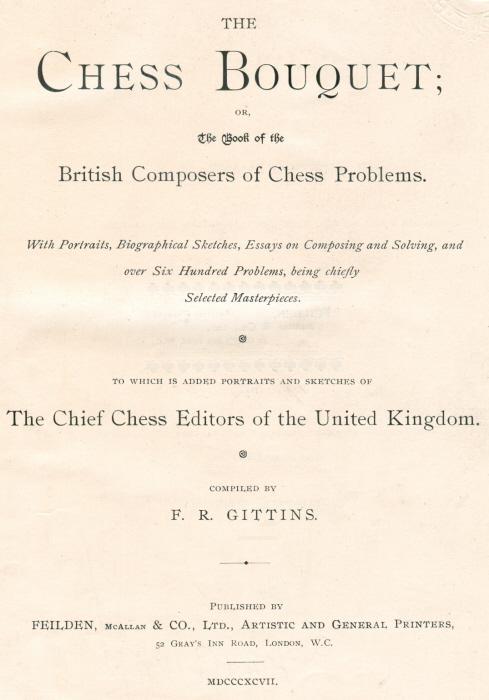
6460. Cook (C.N. 4341)
From Jon Crumiller (Princeton, NJ, USA):
‘The term “cook” was used slightly earlier than the 6 August 1870 date (not counting the possible reference from 1851). Staunton’s Illustrated London News column of 8 January 1870 (page 55) used the word, which he referred to as “slang”.’
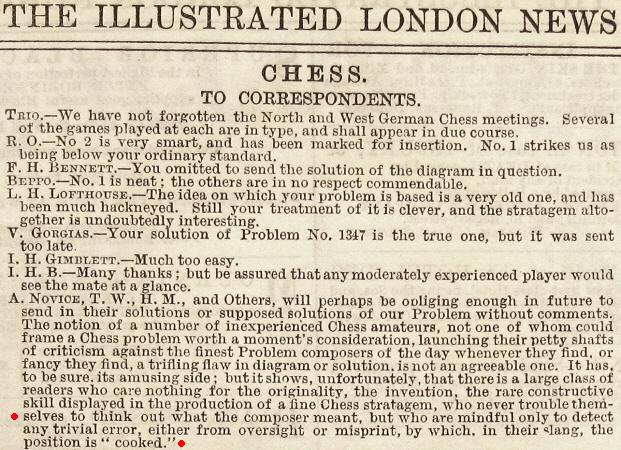
6461. Poisoned pawn
Who introduced the term ‘poisoned pawn’? It appears on page 255 of the second volume of Alekhine’s Best Games (in a note to White’s 15th move in Alekhine’s second match-game against Euwe in 1926), but the earlier German and French texts (in Auf dem Wege zur Weltmeisterschaft and Deux cents parties d’échecs) did not include the notion of poison but merely referred to danger.
6462. Mackenzie game (C.N.s 5926, 5931 & 5951)
Eduardo Bauzá Mercére (New York, NY, USA) comments that G.H. Mackenzie apparently did indeed play the miniature under discussion, since it was published on page 2 of the New York Times, 12 January 1871:
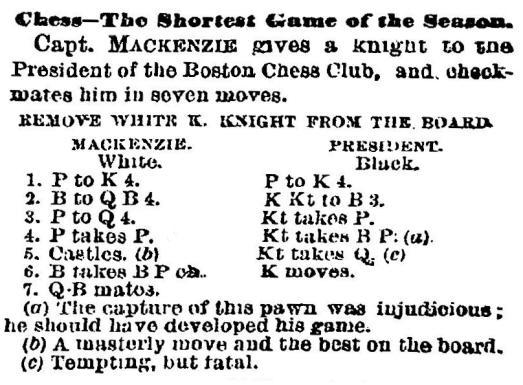
6463. Underpromotion
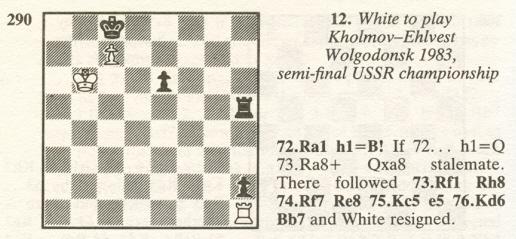
The above comes from page 186 of Chess Curiosities by Tim Krabbé (London, 1985), and Claus van de Vlierd (Oldenburg, Germany) asks whether the full game-score is available.
We note that various databases break off the Kholmov v Ehlvest game in this position, after 40...b5:
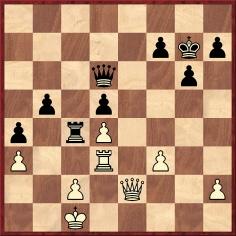
See also pages 916-917 of the October 1996 issue of EG, which states that the score only as far as move 42 was given in the 1/1984 issue of Shakhmatny byulleten.
6464. Spassky v Fischer television coverage
Serin Marshall (Brooklyn, NY, USA) asks whether any recordings have survived of Shelby Lyman’s television programmes on the 1972 world championship match.
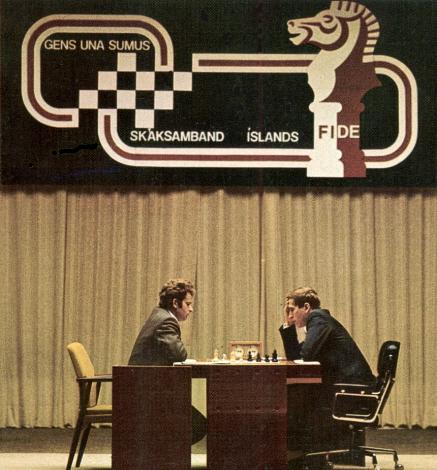
6465. Capablanca’s diplomatic career
Little has been written about the beginnings of Capablanca’s diplomatic career, but Tony Gillam (Nottingham, England) has submitted this report from page 3 of the New-York Tribune, 4 July 1913:

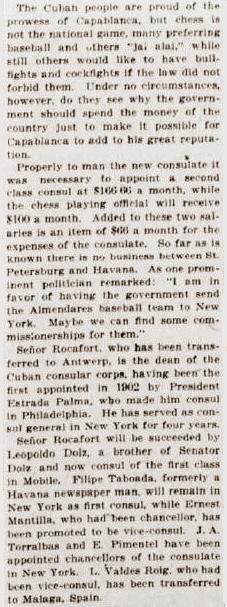
6466. Frederick the Great
A sourceless quote from page 182 of volume one of Chess Generalship by Franklin K. Young (Boston, 1910):

Page 128 of the September 1898 American Chess Magazine had an item entitled ‘Chess Vanity’ which began:
‘Frederick the Great, who played chess passionately and very often, was not a great master in the noble game.’
This was followed by a ‘once’ anecdote. The entire little item had another outing on page 317 of the August 1915 Chess Amateur.
6467.
Saarbrücken, 1953 (Christmas tournament)
Alan McGowan (Waterloo, Canada) sends two photographs from pages 48-49 of the 2/1954 issue of FIDE Revue:
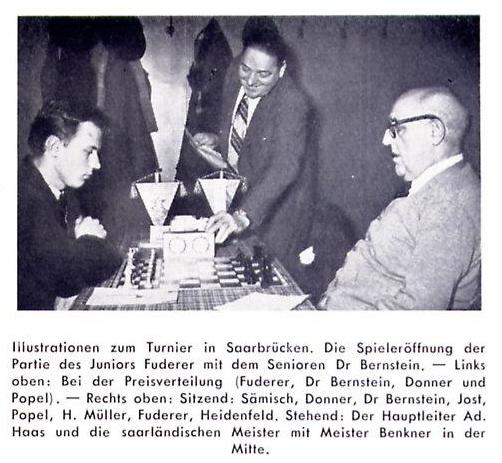
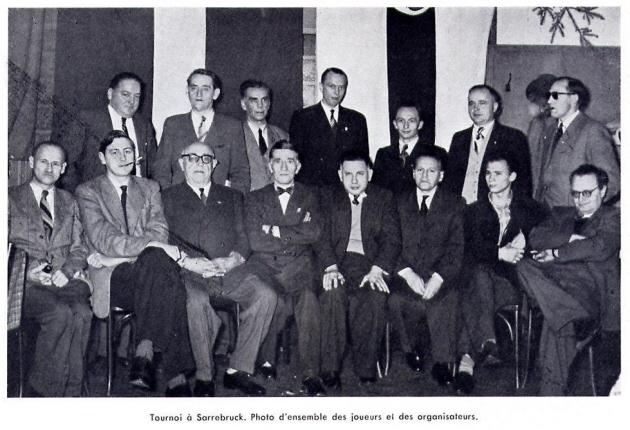
Page 48 gave the crosstable:
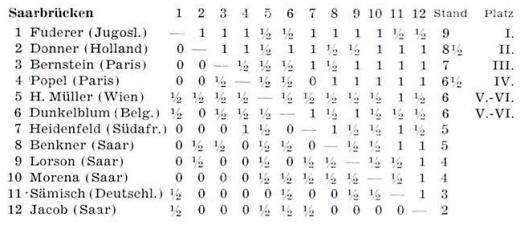
6468. Blindfold chess by women (C.N.
6289)
Information on blindfold displays by women is still being sought. In the meantime, Jerry Spinrad (Nashville, TN, USA) has provided this report concerning Mrs J.W. Gilbert on page 1 of the Hartford Weekly Times, 4 November 1871:
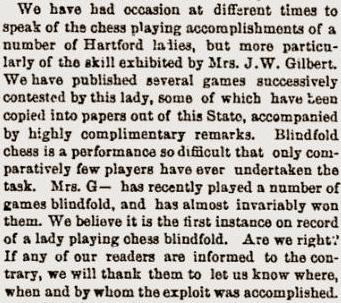
6469. Pride and sorrow
As noted in The Pride and Sorrow of Chess, the exact origins of that epithet for Morphy have yet to be discovered. Our article quoted from page 113 of the April 1885 International Chess Magazine, where Steinitz wrote:
‘... the fearful misfortune which ultimately befell “the pride and sorrow of chess”, as Sheriff Spens justly calls Morphy, can only evoke the warmest sympathy in every human breast.’
It may be added that on page 3 of the January 1885 issue of his magazine Steinitz had mentioned the phrase with a second definite article but no reference to Spens:
‘The pride and the sorrow of chess, as Morphy has been called, is gone for ever.’
6470. Blackburne Shilling Gambit (C.N. 3786)
From page 429 of the December 1897 American Chess Magazine:
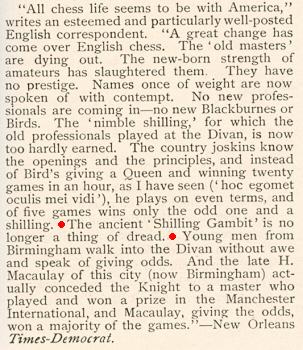
6471. Century Club
From Dimitri Reinderman (Amsterdam):
‘V. Korchnoi has played against G. Levenfish (born 1889) and F. Caruana (born 1992), a difference of 103 years. What is the record in this “century club”, with respect to tournament and match games? The greatest difference that I have found, 108 years, concerns O. Bernstein, who played against J. Mortimer (born 1833) at Ostend, 1907 and against F. Kuijpers (born 1941) at Amsterdam, 1961.’
6472. Historical ratings
Rod Edwards (Victoria, BC, Canada) draws our attention to his website Edo Historical Chess Ratings.
6473. Portraits
From page 33 of the 1927 issue of Chess Pie:
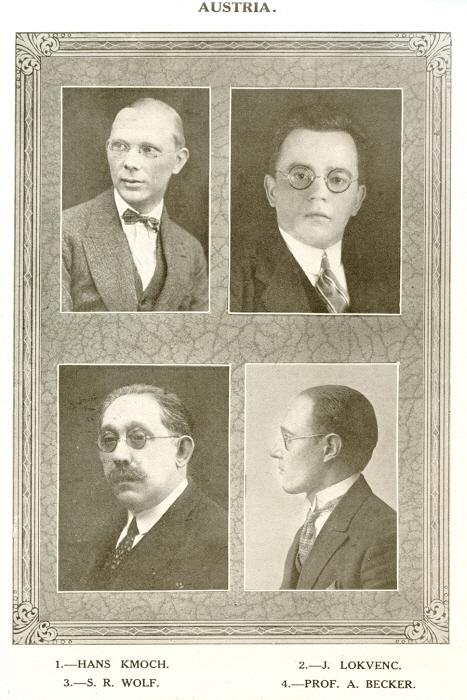
6474. Saarbrücken, 1953 (C.N. 6467)
Leonard Barden (London) informs us that in the second photograph the seated figure identified by FIDE Revue as S. Popel is A. Dunkelblum, and that Popel is standing third from the left.
6475. Century Club (C.N. 6471)
From Eduardo Bauzá Mercére (New York, NY, USA):
‘F. Benkö, who died on 11 January 2010, played against B.H. Villegas (born 1877) at the Torneo Mayor, Buenos Aires, 1938, and against K. Paveto (born 1992) at the Despedida Open, Buenos Aires, 2008, which gives a gap of 115 years.’
Andrew Bull (Cheltenham, England) writes:
‘The subject has also been discussed in item 271 of Tim Krabbé’s Open Chess Diary. The answer depends, of course, on the level of game accepted, but the largest gap suggested (117 years) concerns F. Parr, who played against A.J. Mackenzie (born 1871) at Hastings, 1939-40 and against T. Sharp (born 1988) in the Challengers’ tournament at Hastings, 2002-03.’
| First column | << previous | Archives [66] | next >> | Current column |
Copyright: Edward Winter. All rights reserved.

